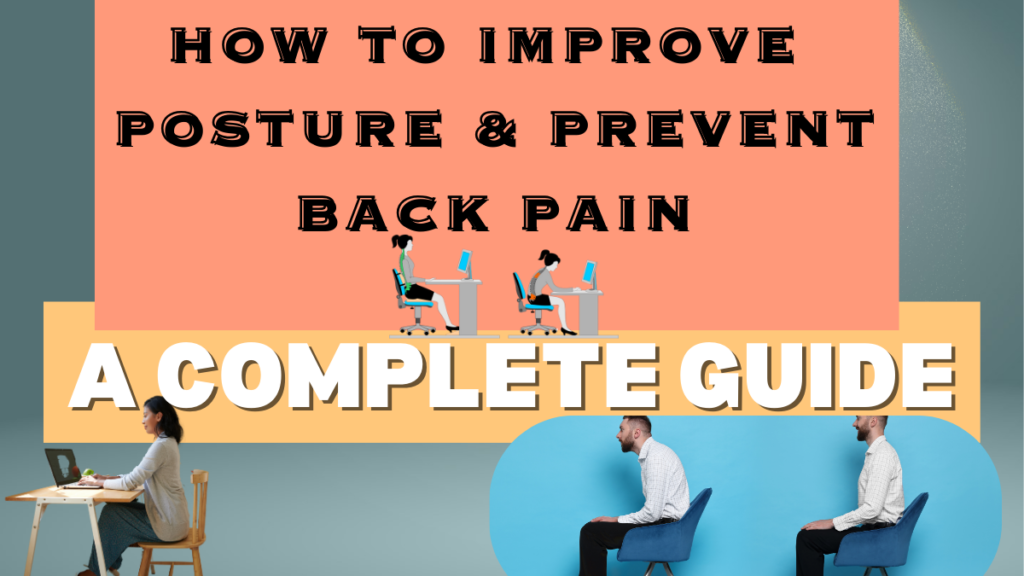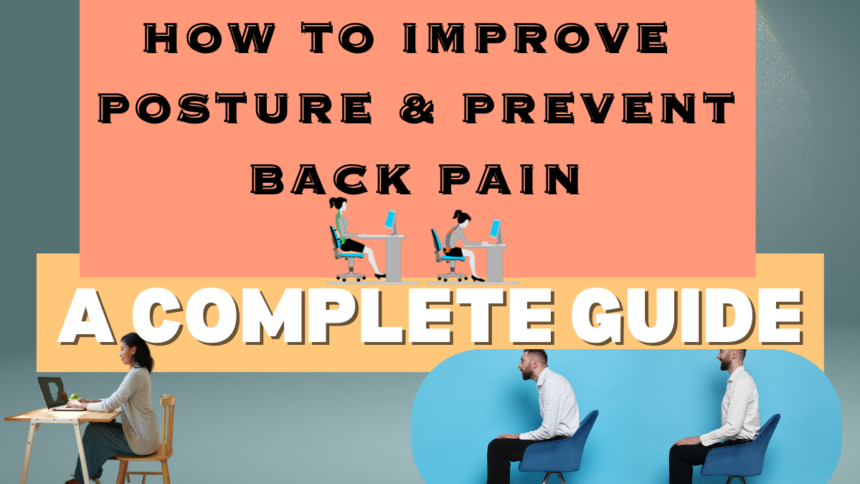Improve Posture & Prevent Back Pain
Do you catch yourself slouching at your desk or waking up with a stiff back? You’re not alone. Poor posture isn’t just an aesthetic issue—it can lead to chronic back pain, reduced mobility, and even headaches. The good news? With a few simple adjustments, you can correct your posture, strengthen your core, and say goodbye to nagging back pain for good.

In this guide, we’ll break down the science of posture, explain how it affects your spine, and share practical tips to improve posture and prevent back pain—whether you’re sitting at a desk, standing, or sleeping.
Why Does Posture Matter?
Posture is how you hold your body while sitting, standing, or moving. Good posture keeps your bones and joints aligned, reduces muscle strain, and helps prevent back pain. Poor posture, on the other hand, can lead to:
- Chronic back, neck, and shoulder pain
- Reduced lung capacity (slouching compresses your diaphragm)
- Digestive issues (poor posture can affect organ function)
- Increased risk of spinal degeneration
A study published in The Journal of Physical Therapy Science found that correcting posture significantly reduced musculoskeletal pain in office workers.
Common Posture Mistakes (And How to Fix Them)
1. The Desk Slouch
Problem: Leaning forward, rounded shoulders, and a curved spine while working.
Fix:
- Sit with your back straight and shoulders relaxed.
- Keep feet flat on the floor, knees at a 90-degree angle.
- Use a lumbar roll or cushion to support your lower back.
Video Credits
2. Text Neck
Problem: Looking down at your phone or laptop strains the neck muscles.
Fix:
- Hold your phone at eye level.
- Adjust your monitor so the top is at eye level.
- Take frequent breaks to stretch your neck.
3. Standing with a Swayback
Problem: Locking your knees and arching your lower back while standing.
Fix:
- Stand with feet shoulder-width apart.
- Engage your core to keep your spine neutral.
- Shift weight from heels to toes occasionally.
4. Sleeping in a Poor Position
Problem: Stomach sleeping or using the wrong pillow can misalign your spine.
Fix:
- Sleep on your back or side with a supportive pillow.
- Place a pillow under your knees (if on your back) or between your knees (if on your side).
5 Effective Exercises to Improve Posture
Strengthening your core and back muscles is key to maintaining good posture. Try these exercises daily:
1. Chin Tucks
- How: Gently tuck your chin toward your chest, keeping your head level.
- Why: Strengthens neck muscles and counteracts “text neck.”
2. Shoulder Blade Squeezes
- How: Sit or stand tall, squeeze your shoulder blades together, and hold for 5 seconds.
- Why: Opens up the chest and corrects rounded shoulders.
3. Cat-Cow Stretch
- How: On all fours, alternate between arching your back (cat) and dipping it (cow).
- Why: Improves spinal flexibility and relieves tension.
4. Plank
- How: Hold a push-up position with a straight back for 30+ seconds.
- Why: Strengthens core muscles that support posture.
5. Wall Angels
- How: Stand against a wall, arms in a “W” shape, and slide them up and down.
- Why: Improves shoulder mobility and alignment.
Daily Habits for Better Posture & Back Pain Prevention
1. Set Up an Ergonomic Workspace
- Adjust your chair height so your feet rest flat.
- Keep your monitor at eye level to avoid neck strain.
- Use a standing desk (or alternate sitting and standing).
2. Move Frequently
- Take a 2-minute stretch break every 30 minutes.
- Walk around to reset your posture.
3. Strengthen Your Core
- A strong core supports your spine—try yoga, Pilates, or strength training.
4. Wear Supportive Shoes
- Avoid high heels or flat shoes with no arch support.
5. Sleep Smart
- Choose a medium-firm mattress for proper spinal alignment.
Myths vs. Facts About Posture
❌ Myth: “Sitting up straight means being rigid.”
✅ Fact: Good posture is relaxed and natural, not forced.
❌ Myth: “Only older people need to worry about posture.”
✅ Fact: Poor posture habits start young and worsen over time.
❌ Myth: “Back braces fix posture permanently.”
✅ Fact: Braces help temporarily, but strength and awareness are key for long-term improvement.
Final Thoughts: Small Changes, Big Results
Improving your posture isn’t about sitting perfectly all day—it’s about making small, consistent adjustments that add up over time. By strengthening your core, setting up an ergonomic workspace, and staying mindful of your alignment, you can prevent back pain and move with ease.
Which posture tip will you try first? Share in the comments below!











